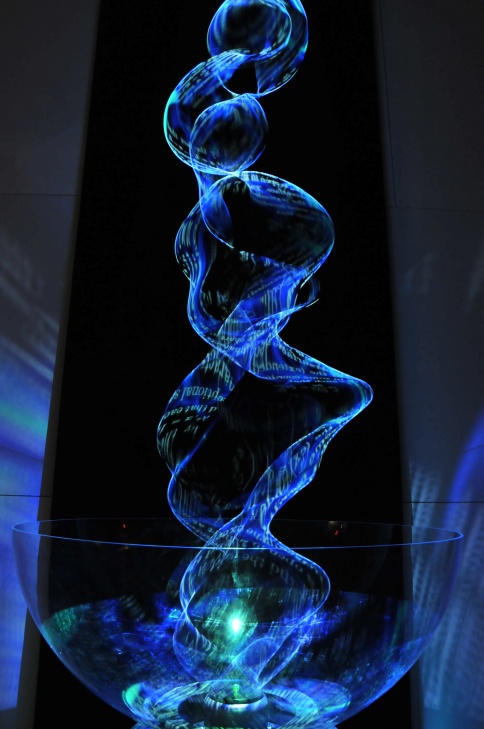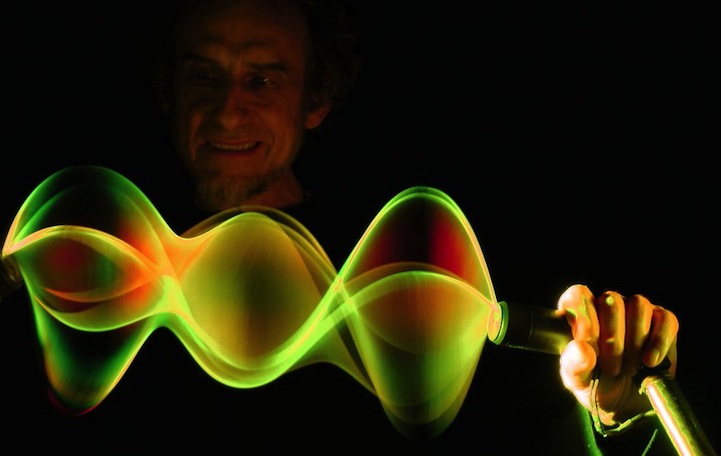Paul Friedlander is both a physicist and a light sculptor, using applied sciences to create art that’s both beautiful and interactive. He constructs kinetic light sculptures by quickly rotating a rope stretched from ceiling to floor through white light. The vibrating string becomes invisible, but the white light that’s being reflected off the rope becomes visible in an exchange that let’s our eyes see magic, as real as science can make it.
The colors change and twist, forming double-helixes that stem from the shape of the swinging rope. Some of these light sculptures are small and handheld, but many of the larger ones include touch screens that allow viewers to adjust the beams. All of them are spinning at very high speeds that result in a constantly moving body of light.
The light dances and vibrates before you, creating spectrums of color that turn science into performance art. Some of the lights spring from clear bowls that make them look like long shiny ribbons reaching down to us. In this video, the ropes of light spin rapidly, changing from one dense color to one another as the each seems to melt off in succession.
Friedlander wrote that he’s been obsessed with machinery and movement since he was little – with the memory of spending six months as a child in New York, surrounded by the skyscrapers and cars and busses developing in the 1950s. He came to New York because his father was a mathematician who was offered the chance to spend six months researching for New York University. (Even though it’s a huge school, having just graduated from NYU myself feels like I have one little thread of connection to the development of this Englishman who’s combined art and science.)
It’s interesting because after graduating from Sussex University, and learning under Sir Anthony Leggett who later was awarded a Nobel Prize for his work on superfluidity, Friedlander attended art school but found its culture completely backwards and its mindset surprisingly small. No one was interested in beauty, he wrote, apparently it was out of date, “passe”:
“The big new thing was conceptualism. I came to consider the art world as some kind of strange fashion following cult. Members of the art world all shared the same views, talked nonsense and froze out any one who dared to consider their own talent more important than following what every one else was doing.”
On a personal note: I find this incredibly interesting, because it’s that exact attitude I want to spend my life trying to change – people shouldn’t think that art can be this over here, but not that over there because it’s already been done. To me, art is the greatest because each time a different pair of hands make something, even if it’s intended to be a copy of something else, it will always be a completely different interpretation of what came before. Art, by nature, should always by new, instantaneous – capturing one brush stroke or one moment in time that deserves to be shared with the rest of us. And we should always be expanding our idea of what art is, since some of the best art sits right on the edge of nonsense.
But I guess in Mr. Friedlander’s case, his art made too much sense.
Now, Friedlander has shown his light sculptures in four continents and fifteen countries, his work having the unique benefit of blending it at both science and art museums. After a brief stint in stage lighting and starting a family, and after feeling a deep sense of being unfulfilled he began experimenting with light in his own way.
Once he “discovered the chaotic properties of spinning string and chromastrobic light,” Friedlander organized a group of artists for an exhibition they titled “Chaos” and he found that his kinetic light sculptures were actually in when it came to contemporary art tastes. He’s been creating, exhibiting, and winning awards ever since.
If you’d like to read Mr. Friedlander’s story for yourself, he wrote a bio page from which all of this information was gathered.
And for more kinetic light sculptures, see his website.
All images via My Modern Met.
loading...








